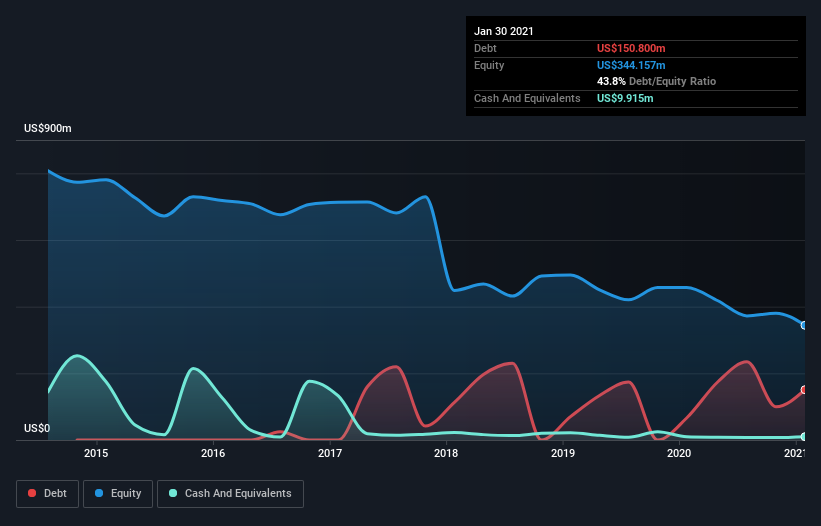- United States
- /
- Specialty Stores
- /
- NYSE:BNED
Barnes & Noble Education (NYSE:BNED) Has Debt But No Earnings; Should You Worry?

The external fund manager backed by Berkshire Hathaway's Charlie Munger, Li Lu, makes no bones about it when he says 'The biggest investment risk is not the volatility of prices, but whether you will suffer a permanent loss of capital.' When we think about how risky a company is, we always like to look at its use of debt, since debt overload can lead to ruin. As with many other companies Barnes & Noble Education, Inc. (NYSE:BNED) makes use of debt. But is this debt a concern to shareholders?
Why Does Debt Bring Risk?
Debt assists a business until the business has trouble paying it off, either with new capital or with free cash flow. In the worst case scenario, a company can go bankrupt if it cannot pay its creditors. However, a more frequent (but still costly) occurrence is where a company must issue shares at bargain-basement prices, permanently diluting shareholders, just to shore up its balance sheet. Of course, the upside of debt is that it often represents cheap capital, especially when it replaces dilution in a company with the ability to reinvest at high rates of return. The first thing to do when considering how much debt a business uses is to look at its cash and debt together.
See our latest analysis for Barnes & Noble Education
What Is Barnes & Noble Education's Debt?
As you can see below, at the end of January 2021, Barnes & Noble Education had US$150.8m of debt, up from US$65.9m a year ago. Click the image for more detail. However, because it has a cash reserve of US$9.92m, its net debt is less, at about US$140.9m.

How Healthy Is Barnes & Noble Education's Balance Sheet?
Zooming in on the latest balance sheet data, we can see that Barnes & Noble Education had liabilities of US$550.2m due within 12 months and liabilities of US$394.1m due beyond that. Offsetting this, it had US$9.92m in cash and US$227.2m in receivables that were due within 12 months. So its liabilities total US$707.2m more than the combination of its cash and short-term receivables.
The deficiency here weighs heavily on the US$353.5m company itself, as if a child were struggling under the weight of an enormous back-pack full of books, his sports gear, and a trumpet. So we'd watch its balance sheet closely, without a doubt. At the end of the day, Barnes & Noble Education would probably need a major re-capitalization if its creditors were to demand repayment. When analysing debt levels, the balance sheet is the obvious place to start. But it is future earnings, more than anything, that will determine Barnes & Noble Education's ability to maintain a healthy balance sheet going forward. So if you want to see what the professionals think, you might find this free report on analyst profit forecasts to be interesting.
Over 12 months, Barnes & Noble Education made a loss at the EBIT level, and saw its revenue drop to US$1.5b, which is a fall of 24%. That makes us nervous, to say the least.
Caveat Emptor
While Barnes & Noble Education's falling revenue is about as heartwarming as a wet blanket, arguably its earnings before interest and tax (EBIT) loss is even less appealing. Indeed, it lost a very considerable US$121m at the EBIT level. Considering that alongside the liabilities mentioned above make us nervous about the company. It would need to improve its operations quickly for us to be interested in it. Not least because it burned through US$102m in negative free cash flow over the last year. That means it's on the risky side of things. When analysing debt levels, the balance sheet is the obvious place to start. However, not all investment risk resides within the balance sheet - far from it. We've identified 4 warning signs with Barnes & Noble Education (at least 1 which is significant) , and understanding them should be part of your investment process.
If you're interested in investing in businesses that can grow profits without the burden of debt, then check out this free list of growing businesses that have net cash on the balance sheet.
If you decide to trade Barnes & Noble Education, use the lowest-cost* platform that is rated #1 Overall by Barron’s, Interactive Brokers. Trade stocks, options, futures, forex, bonds and funds on 135 markets, all from a single integrated account. Promoted
Valuation is complex, but we're here to simplify it.
Discover if Barnes & Noble Education might be undervalued or overvalued with our detailed analysis, featuring fair value estimates, potential risks, dividends, insider trades, and its financial condition.
Access Free AnalysisThis article by Simply Wall St is general in nature. It does not constitute a recommendation to buy or sell any stock, and does not take account of your objectives, or your financial situation. We aim to bring you long-term focused analysis driven by fundamental data. Note that our analysis may not factor in the latest price-sensitive company announcements or qualitative material. Simply Wall St has no position in any stocks mentioned.
*Interactive Brokers Rated Lowest Cost Broker by StockBrokers.com Annual Online Review 2020
Have feedback on this article? Concerned about the content? Get in touch with us directly. Alternatively, email editorial-team (at) simplywallst.com.
About NYSE:BNED
Barnes & Noble Education
Operates bookstores for college and university campuses, and K-12 institutions primarily in the United States.
Low and slightly overvalued.
Similar Companies
Market Insights
Community Narratives



